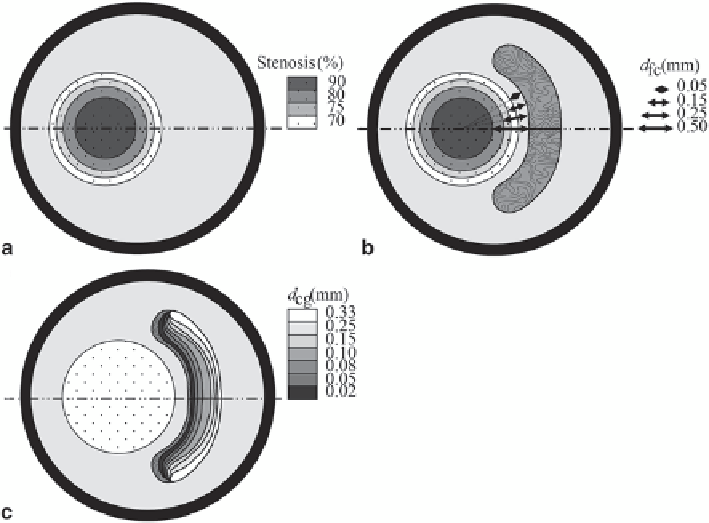Biomedical Engineering Reference
In-Depth Information
Fig. 8.30
Design of models based on varying geometrical configurations. (
a
) fibrous plaque
geometry uses a constant material (
b
) fibrous plaque geometry uses a composite matrix and a
constant lipid core (
c
) a set of calcified plaques which comprises of a varying calcification gap
d
cg
(
from 0�02 to 0�33 mm
)
The fibrous material from the plaque occupies the interior wall of an artery such
that a lumen of varying size is formed. The lumen is modelled with an eccentricity
of 0.5 mm with respect to arterial centre, and with varying lumen diameter
L
that
corresponds to percentage of stenosis.
The fibrous cap is assumed with the same material make-up as the plaque. For
the lipids, a subintimal substance is constructed by extending a 140
o
crescent with
thickness of 0.35 mm (Fig.
8.30a
). The calcification gap refers to a lipid gap be-
tween fibrous cap and calcification agglomerate (Fig.
8.30b
). The plaque morphol-
ogy is based on fibrous cap width
d
fc
, thickness of calcification agglomerate
d
cag
,
and calcification gap
d
cg
. A range of stenosis at 70, 75, 80 and 90 % are modelled.
As the position of lipid core (of constant thickness of 0.35 mm) remains consistent,
the stenotic reduction results in thinning of fibrous cap.
8.5.1.2
Plaque Rupture Mechanics
Anisotropic modelling of atherosclerotic vessel can be implemented to probe
plaque vulnerability (Cheng et al. 1993b; Loree et al. 1992) where a two-
dimensional modelling platform for calibrating the extent of plaque rupture is
based on mechanical parameters governing the atherosclerotic configuration.

Search WWH ::

Custom Search